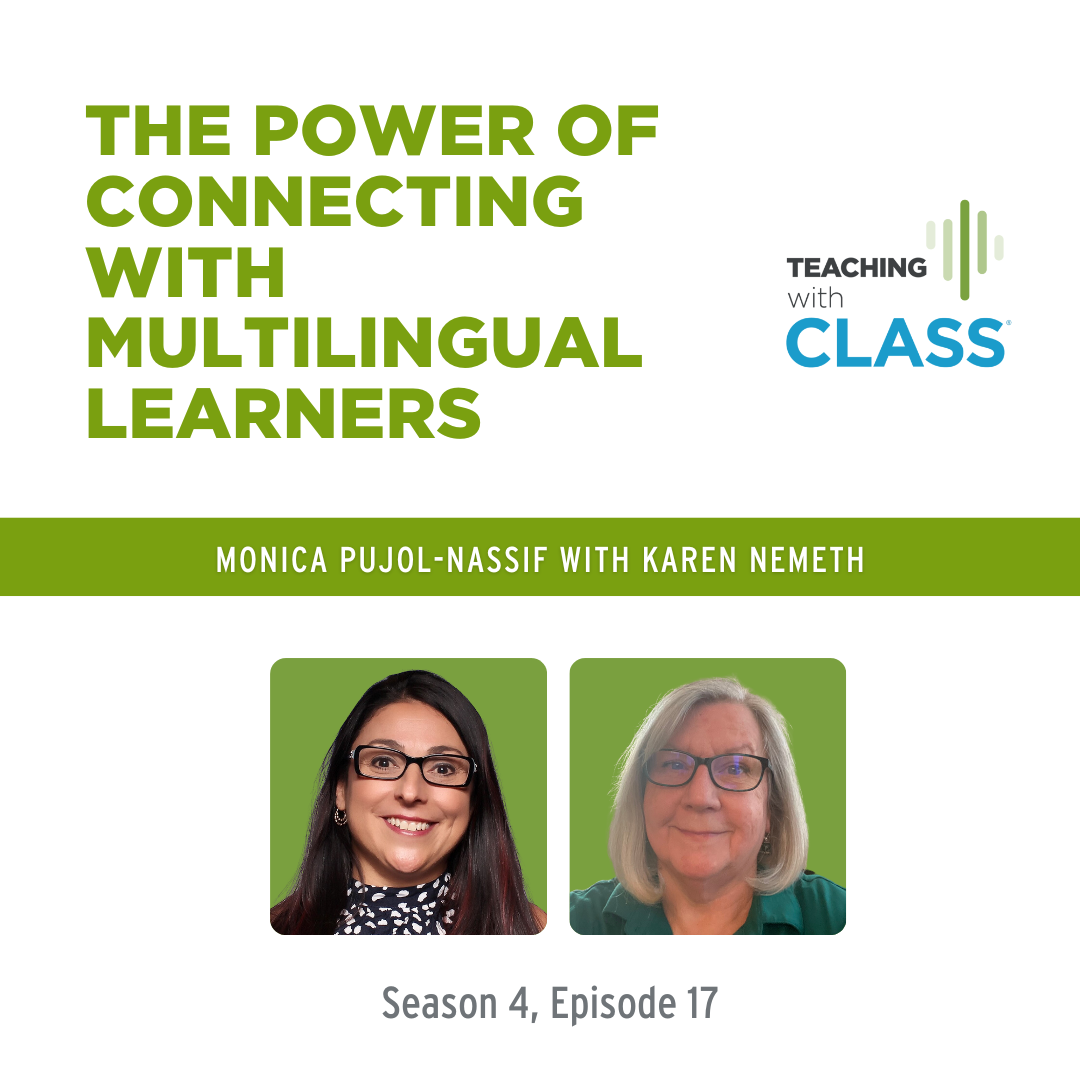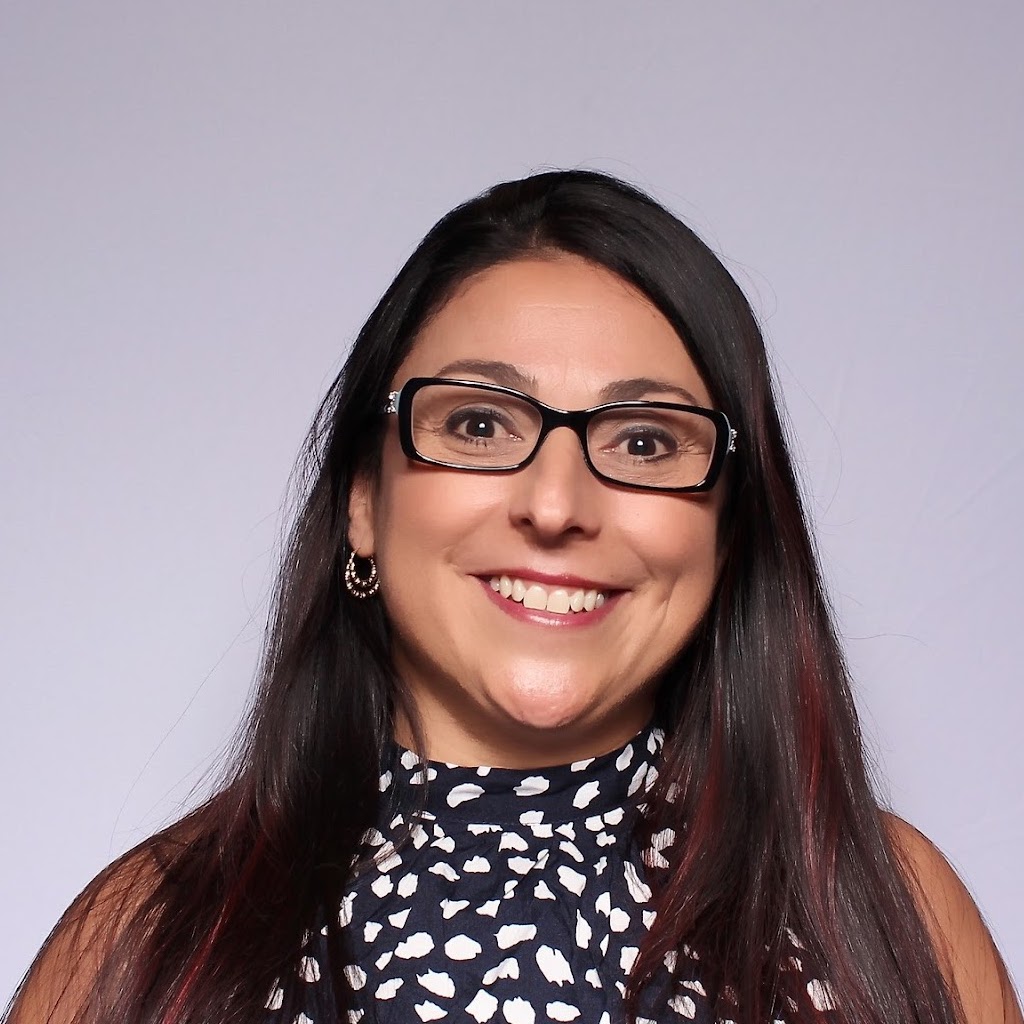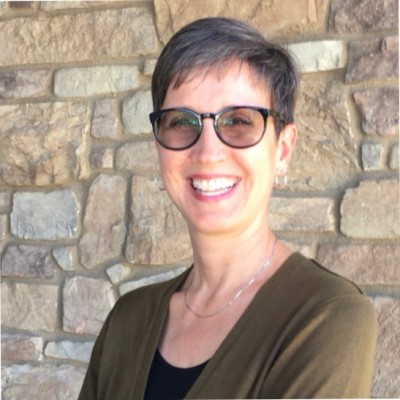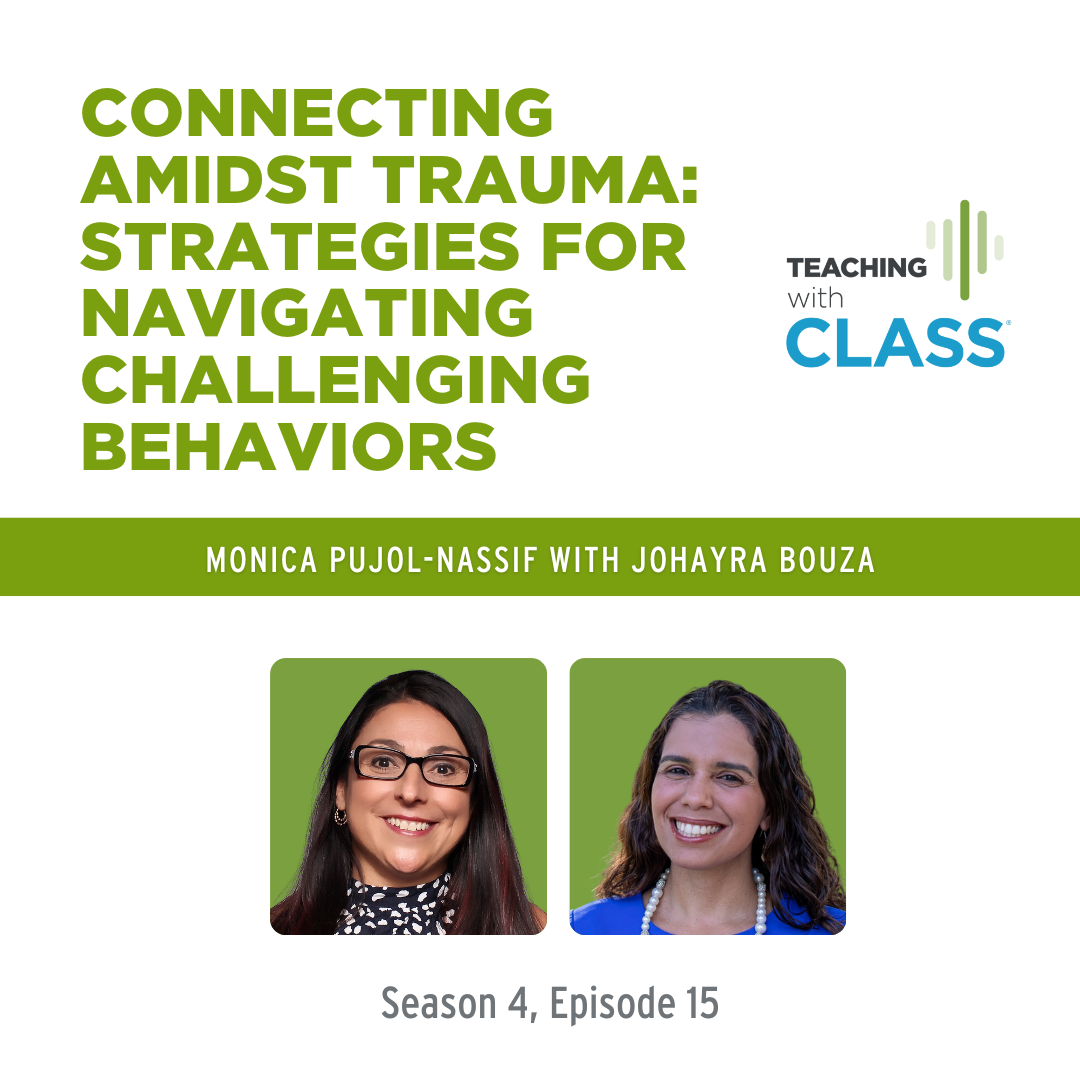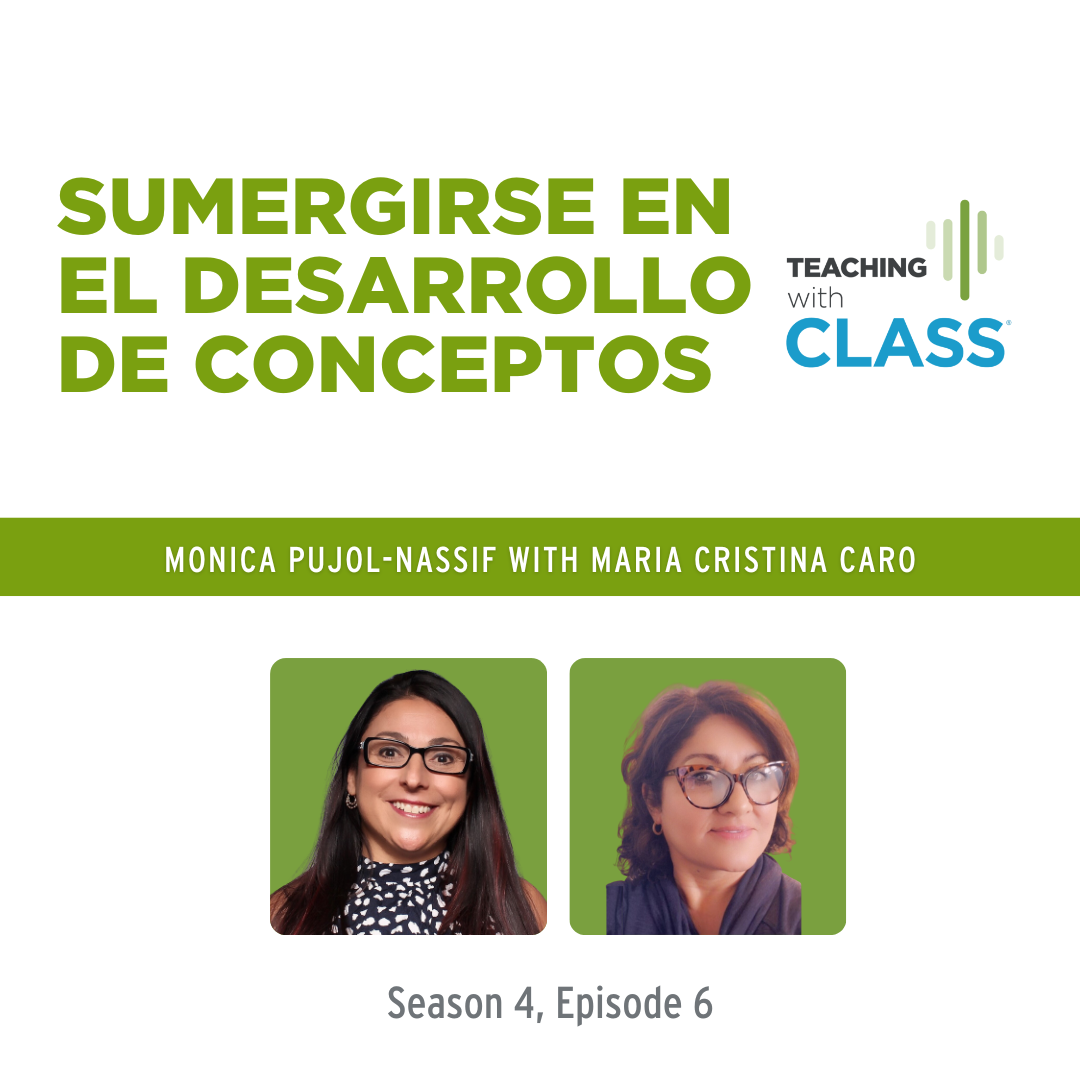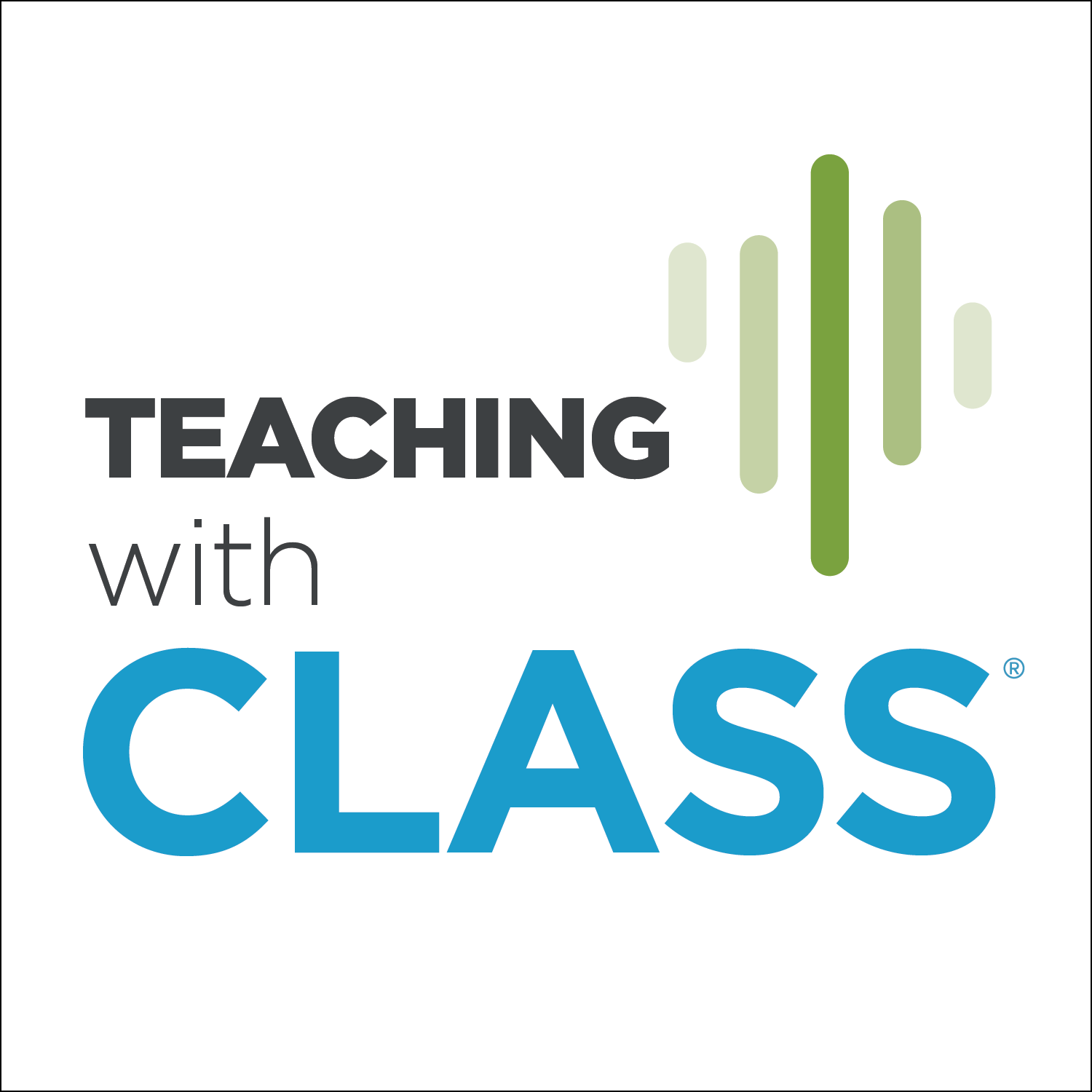Episode Transcript
Monica: Hello and welcome to the Teaching with CLASS podcast, the podcast that gives you quick, actionable tips to easily implement in the classroom. I'm your host, Monica Pujol-Nassif.
In today's episode, we'll be focusing on the multilingual learners in your classroom and how to connect with them in meaningful ways. We are joined today by Karen Nemeth, who is the author, consultant, and advocate focusing on high quality early learning experiences for young multilingual learners.
Karen, thank you so much for being with us today and for wanting to share your expertise with our teachers. Can you please tell us a little bit about yourself first?
Karen: Thank you for having me. I will say that my background is in the study of language development—first language development and second language development.
Over the years, my work has had me in a university setting or in nonprofit organizations, working with government agencies, the office of Head Start, with school districts on supporting early learning for first and second language learners.
In that work, I've had a lot of opportunities to visit so many classrooms. I worked with the New Jersey Department of Education in the Office of Preschool. We got to see Head Start settings, private preschool settings, and school district settings. I've been able to visit other countries and visit their early childhood programs as well.
I've used those experiences to learn more about what the research says about how language develops and what we need to do to support language development, as well as what early childhood educators say, what they ask, and what they need to know about supporting children who are multilingual learners.
Over time, I started to write books about those topics and articles, collaborate with authors from all different aspects of the field, do talks about these things, keynote addresses, podcasts, et cetera, to bring together questions that early childhood educators have, as well as the answers that are available in the field from different parts of the field. That's my professional background.
I do have one little story that I like to share, about the time that I was a state specialist with my suit and clipboard visiting Head Start classroom. A little child came up to me. I was a perfect stranger, never been there before. That little boy came up and pulled on my trousers and said, Miss, you take me, mommy. His lip was quivering and his tears.
At that moment, I realized I can't keep thinking like a person with a clipboard anymore. We need to work more on what helps these children. What is their experience like to be away from home for the first time in an environment where people don't understand their language, where they don't understand the language? How do they feel and how will that impact their learning and development? It's all to that little boy that this path has taken this shape.
Monica: When I hear those testimonials, it's so hard to hear the moments when the child goes through something, this moment was just sad and missing mom. He came to you, a person who he didn't even know. That's why you're here. You want to talk about the importance of connection with children who can't understand the teachers or the teachers can't understand the children, because those connections are as important as for anybody else.
Karen: Absolutely.
Monica: Let's start with defining. Will you define what is a multilingual or dual language learner? How will you define that?
Karen: That is a really important question because the answer comes from the research and pushes us forward to improve our work. The official definition of dual language learner was started with Head Start back in about 2008, as they pulled researchers together to discuss this topic. The term ‘dual language learner’ became the official term that's used by the Administration for Children and Families, the US Department of Education, National Association for Education of Young Children.
It says that a dual language learner is a young child who is growing up with two or more languages, whether those languages are simultaneously—a family where the child is born with a mother that speaks one language and a father that speaks another language—or sequentially—like a child who starts with one language, then they move to a new community or a new school, and they learn an additional language.
All young children who are learning in two or more languages think in two or more languages. Research says they need to be supported in both of their languages or all of their languages.
The official definition and the research-based definition does not ask how proficient they are, doesn't ask for a test score. It doesn't matter how well they're doing in one language or another, because if they are learning in two languages, no matter how much or little, some of their thinking, some of their knowledge is coded in their brain in each of those languages.
As effective early childhood educators, we need to connect with all of those early knowledge experiences, language experiences, and also the interpersonal relationship-based experiences that can happen in both languages. It's a big answer to what seemed like a short question.
Monica: Very important answer because it gets us thinking and talking, what are we talking about here? You are saying, we don't need to be proficient in all the languages to be able to support children because they can learn. They can learn in multiple languages. Their brain, we are built for that as human beings, so they can. And speaking more than one language is a strength.
Karen: It's a superpower. Being bilingual is a superpower. I borrowed that quote from somewhere. Now, of course, I can't remember where, but it's a really good quote. So thank you to whoever started that quote.
Monica: I love it, it's a super power. Let's talk about what interactions look like when the adult and the child speak different languages.
Karen: I think that what we see and what we should see aren’t two different things sometimes. I think that many times when teachers go to college, university, they don't get the in-depth background they need to be prepared to teach young children who speak different languages. A lot of times they're out there trying their best, trying different things.
We can have a role in providing more support, more detail that would help them have a better understanding of how to really emphasize nonverbal communication to support those interactions, how to emphasize high quality observations so that you really focus on getting to know the child and all of the child's ways of expressing to you, even before that child is fluent in the teacher's language. They are still communicating. They are still having interactions with you. They're just not necessarily spoken words.
The third thing would be, how can teachers focus more on supporting comprehension? Their research is really showing us that the more children know—the more knowledge they have, the more background information they have—the further and stronger their language can progress.
The focus should not be on teaching English. The focus should be on having high quality two-way interactions that help children understand and learn background knowledge so they can use that knowledge to build their home language and their English language.
Those three things—nonverbal communication, observing the child, and then really intentionally supporting comprehension—are things that we should be seeing more of.
Monica: Thank you so much. Yeah, absolutely. What you are saying is aligned with everything that CLASS (obviously) is doing out there with the interactions, the nonverbal communication.
Please tell us, what does that research tell us about how multilingual learners can thrive in an early childhood education setting?
Karen: That is another question that has a multi-part answer because children are made up with multiple parts. It isn't just about language itself, but it's about the whole world of language environment that we provide for those children.
Part of it is the new research that's really reminding us, again, something that is so central to the CLASS understanding of what works for young children. It is the need for two-way conversation. High quality, two-sided instructional interactions that allow children to think about what the teacher is saying or communicating, to process it, to come up with their answer, to express what they know and can do.
If they don't share the same language, teachers have to learn to ask questions in different ways or to ask questions in the home language. They have to learn ways to support the child so that the child can understand the question and answer the question. That has multiple parts to even the first part.
One of them is making sure that as a teacher, you’re making time to focus on each child, and that you are finding a way to have a two-way interaction with a child that is not fluent in your language, but that you are still attending to them, responding to their interests, using your nonverbal communication, that you are not leaving out the child that's harder to communicate with.
There are always children in your class that are easy to communicate with. They are happy to have lots of conversations and they really click with you. It's the ones that may be a little bit on the sidelines.
Maybe it's hard to communicate with them because you don't speak their language. Aren't those really the children that need you the most? So taking the time to pause and really be present with that child, have a two-way interaction and you have to focus, so that the nonverbal components, what they show you, et cetera, can really help that child shine and help that teacher be successful. That's one part of the answer.
The second part of the answer is just a simple trick, which is to give the child time, to give more of a pause when you ask a child a question. You have to pause because a child who's learning in two or more languages or a child who's learning in a new language, their brain takes a little longer to process what you asked, to figure out how they want to answer it, and then find a way to answer it in a way you can understand.
They have more work to do in that two-way conversation than a child who just easily connects with your language. So always give a pause and wait for their response. It's hard for us to do. It's really hard for us to do sometimes. So those are some things we can do to help those children really thrive.
Those things really also depend on a supportive system. We always talk about what teachers should do, and CLASS observes what teachers should do. But in order to do it properly, teachers need the right kinds of support from their coaches, from their bosses, that they need to have the time in order to spend the time to do these things with young children who speak different languages.
Monica: When you were talking, I was thinking something very important that teachers learn some ways to ask questions or interact verbally with children in their home language. How would you suggest teachers can learn this?
Karen: One thing I have learned from speaking with groups all over the country and in other countries, most preschool classrooms have more than two languages. It is really a challenge. We're not just talking about is the teacher bilingual or is it a bilingual class, but what do you do when there are three, four, five, eight different languages in your classroom?
One thing I really encourage is to learn a couple of open-ended, multi-purpose questions that you can ask in every language in your classroom. You could ask a child, what are you making? Or what might happen next?
You could just go home and learn to say those two questions in three or four different languages tonight. You can ask the parents to help you, your coworkers, or the Internet if you need that.
What are you making or what might happen next are two open-ended questions that can start a conversation with any child, get them thinking, get them expressing themselves. If you ask it in the home language, well, the child might answer it in their home language, in which case you might get that feeling of what it's like in an environment where the talker doesn't speak the same language as the listener, and that's okay.
We don't need teachers to control everything that happens in the conversation. We just need those children to be filled with confidence, to express themselves, to be filled with that connection with the teacher that they have, that teacher took the time to ask me about what I'm doing. I feel seen, I feel heard. I've got something to say. I'm doing important stuff here in preschool. They were going to express that.
It turns out, according to the research, that oral language expression for the young children is critical for their ability to learn language and to progress in both their home language and in English.
Two things. It's interesting that supporting their home language actually helps them do better in English, because it builds these foundations that are needed to progress in any language.
Monica: Absolutely. Because you talk about making the pause earlier, even when they're infants, they're learning both languages, as you said earlier, simultaneously. Maybe they come to you—they're four or six—and they already know the language, the grammar. They already have that structure. Practicing is going to make better English.
Karen: Yes, practicing. Not listening but practicing. That is something that is so hard to communicate because in the United States especially, we focus so much on training teachers about what they should say. We don't talk enough in training teachers about how important it is to listen. Those conversations need to be two-sided.
There's just new research that came out this year that emphasizes how important that is for multilingual children, and how hard it is to find those full, deep two-way interactions in preschool. We want to make sure that those multilingual children get the maximum boost, not getting less than other children.
Monica: The minimum.
Karen: Not getting the minimum, exactly.
Monica: Excellent. Let's talk a little bit about banking time. Banking time is something that we promote in the interactions with children when we want to build that connection. How might we engage in banking time when we don't speak the same language as the child?
Karen: I will tell you what. I know banking time is a thing, is a strategy that you promote, but it is for me a feeling. It is a feeling of what it means to be a child and have that moment when, regardless of what's happening all week, that I know I could count on a time when I will be the special one with my teacher. That I will feel that this is my time, I'm important, and I am worthy. I will tell you that, that's not always the case.
We have at times asked teachers to track, not necessarily when they call it banking time, but just in talking about their tracking the times they've had conversations with their young children in their class. When teachers keep a list and keep track of when they've had these special moments of interaction, they realize many times they'll get to the end of the week, there are some children they have many interactions, and some they have never had a conversation with the entire week of school. How must that child feel?
Monica, I see your face, and this is how my face looks when I visit these classrooms. It’s like, oh come on. Banking time is even more critical for a child who is facing challenges all week.
My friends don't all understand me. I'm not sure what the story is about. I don't know what the teacher is saying. I don't know what I'm supposed to do. They gave us these materials, but I don't know what it is. All week they're facing these challenges. Shouldn't they have one moment where there's a settling and a connection with their teacher? That's when the teacher needs to pull out all these strategies that help build that communication.
Here are some tips I would give you, some insider secrets. First of all, really focus on being with the child. Now, when a child speaks your language, you could just sit down and have a chat. It's not so easy when the child and the teacher don't speak the same language, so you might arrange banking time around a play material, something that the child's interested in.
If you know that the child is interested in toy cars, you might sit down with a box of toy cars, just begin playing toy cars together with the child, and use your nonverbal skills or your sound effects—vroom, whatever—to be with the child, have that interaction, use whatever words they can use and whatever words you can use.
Use a shared focus on a play material, not the teacher's idea of a fun play material, but through their vigilant observations, something they know is of interest to the child that they can play with together side by side and be together, make eye contact when it works for that child.
Use the words in the home language that you can. Listen to the child's words, try to repeat what they're saying, and show you're interested in learning. Use your facial expressions and gestures with intention. Really thinking about when I spend time with this child, what seems to really get his attention? What seems to really make him smile? And let me remember that for this child.
It's different. As you certainly well know, some children really need animation and hilariousness. Other children will be intimidated by that much energy and they'll need a quieter connection. It really falls on the teacher's observation skills to get to know each child, and then bring a matching style that will build that in those first moments when you're establishing that nonverbal presence with the child and connecting.
That connection builds that child's confidence and their knowledge, so that their language with the teacher and the teacher's language with the child can grow. How you start banking time when you first meet the child will be different from how it looks a few months down the road, as language begins to grow between you, all floating on the power of that connection.
Monica: The power of that connection, love it. It occurred to me when you were talking, before you mentioned, learn the language of the child as the family or your coworkers. If you know what is interesting to the child, you can ask those words. How do you say car? How do you say truck? How do you say fast? Thank you so much, Ms. Karen.
Karen: I think it's really important to go back to the parents for multiple reasons. Every answer I have is multiple reasons. If you ask the parents, you are also inviting the parents to be your partner. You could look something up online, but you won't build a relationship with the parents if you go around them and look it up online.
Second thing is that the parents may have ways of saying things. You might look up a Spanish word, but it's not the same from family to family, from country to country. Getting it straight from the parents, they will tell you.
The little child that I used to babysit for when I was a teenager said tee-tee when she wanted to use the bathroom. I'm from New Jersey. We don't use that expression. I didn't know, did she want a snack? Did she want iced tea? We had to find out the hard way.
Looking up the correct word won't help you. You need to know what the family uses, and it also helps the family feel that connection. It makes the family so aware that supporting the home language is a good thing. That is the family's contribution to their child's education. It's not a weakness, it's a power. We're talking a lot about power today.
Monica: I know. Love it. Could you share with us key takeaways, things that you want the teachers to take today and go and practice tomorrow when they're with their children?
Karen: One key takeaway is to really make sure that you have one-on-one interaction with each child even when they are not ready to share that interaction fully with spoken language. Make sure you still have those interactions, building that bond, following their interests, and supporting their home language. That's one thing. Make sure to have those and track them, so you know that every child in your classroom is getting the benefit of your skills as your talents as a teacher in that way.
The second takeaway is to make sure that you focus on using the child's home language to help them understand, not just sprinkling home language words, but using home language and nonverbal communication to help them understand, so they can learn what they need in order to participate in those two-way high-quality interactions.
Then the third thing is, don't underestimate the power of those personal connections of really observing them, knowing their interests, pausing to really respect that it's worth waiting for their answer to your questions, and really making sure that each child feels the strength and confidence that you can build with that human relationship that you build with them.
Monica: Thank you. You just mentioned power again, the power of connection. I love that you keep repeating that because we are talking about multilingual families and children, but it comes down to that connection first. So that everything else, once they have that connection, their brain feels ready to learn.
If those children are left on the side and not spoken to, and they have all those fears that you have been mentioning, they're going to be stuck there, not able to progress in their learning.
Thank you so much. I could stay all day speaking with you, of course, and I know that teachers will love to hear more from you. You're everywhere, so that's a gift for your teachers. I really thank you from the bottom of my heart for giving us this time, sharing stories and expertise with us today.
Everybody, you can find today's episode and transcript on our website, teachstone.com/podcasts. Thank you, architects of the mind, for sharing your love and wisdom with the children of the world, and for being here to add to your box of wonders. I'll see you next time. Bye-bye.
